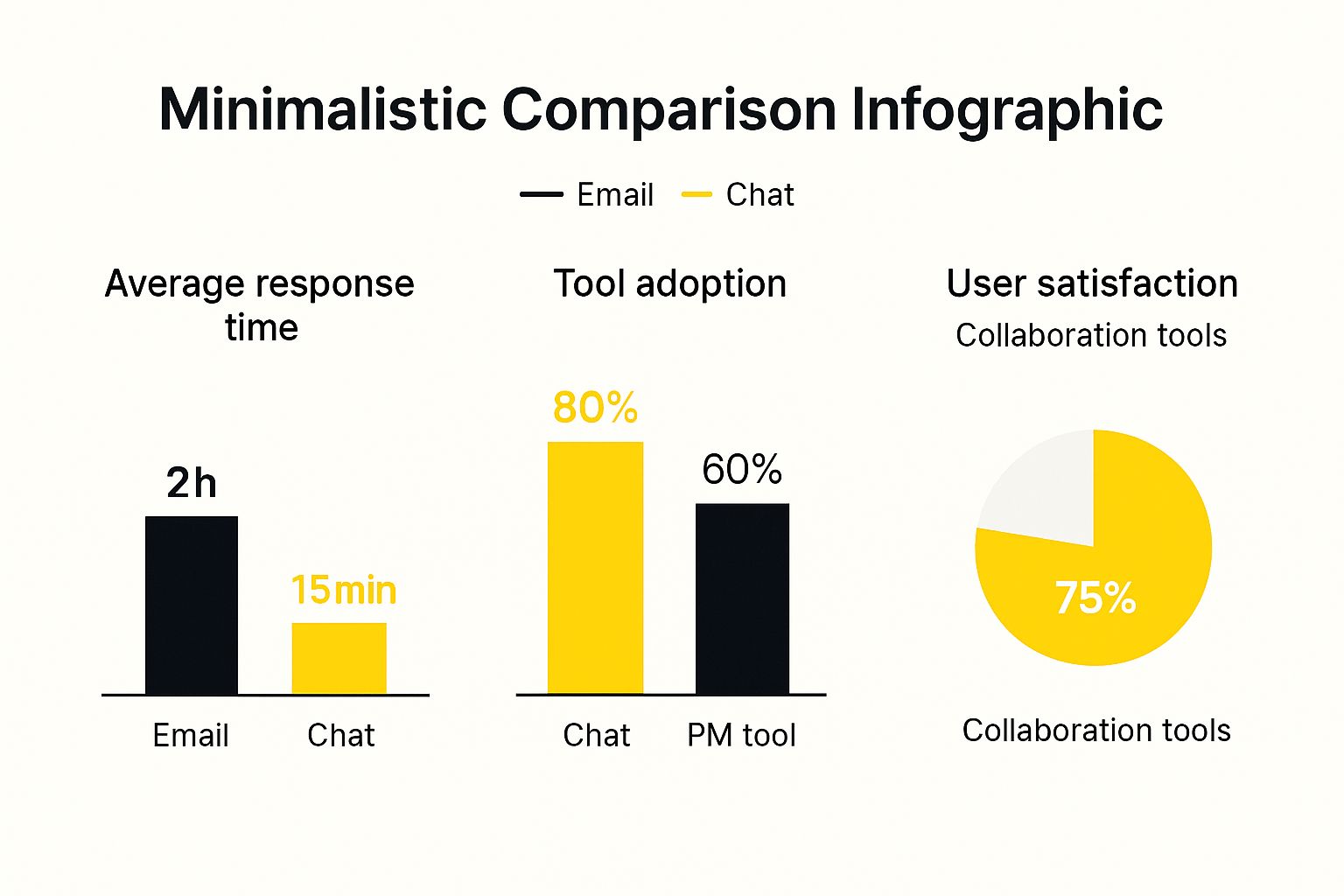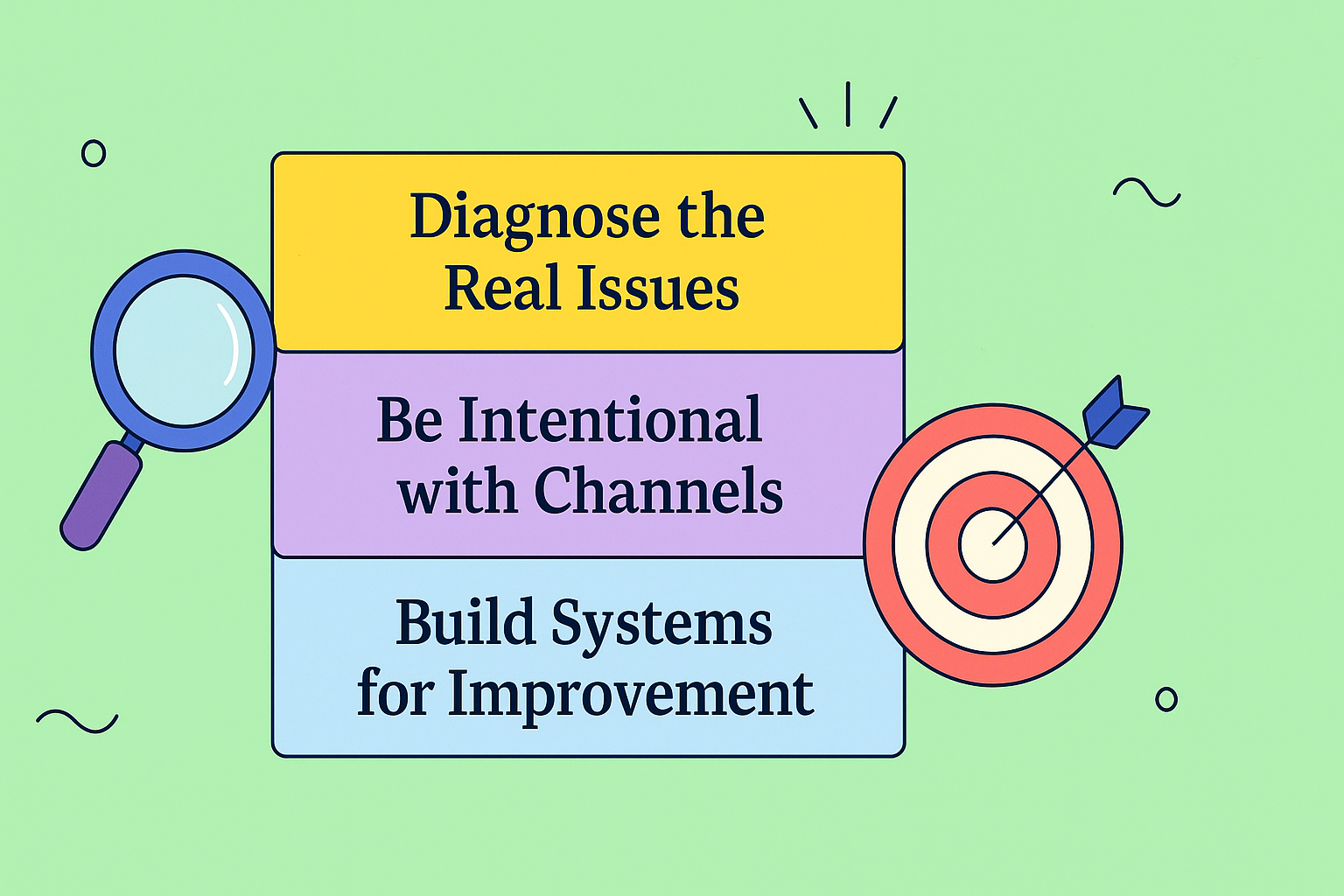To truly get a handle on team communication, you need a plan that goes beyond just telling people to “talk more.” It’s about first figuring out what’s actually broken, then getting deliberate about how and when you communicate, and finally, building in ways to keep getting better. This is how you move from dealing with constant misunderstandings to building a culture of genuine clarity and trust.
Why Most Team Communication Fails (And How to Fix It)
Let’s be real—poor team communication is more than a small frustration. It’s a quiet killer of productivity, morale, and even your company’s bottom line. We’ve all been there: tangled email threads where key details get lost, vague requests that lead to hours of rework, and that pit in your stomach from a misinterpreted Slack message.
These aren’t just one-off bad days; they’re symptoms of a bigger, systemic issue. The financial hit is staggering. One study found that large companies lose an average of $62.4 million every year from miscommunication alone. The human cost is just as high, with 80% of US employees saying they feel anxious at work because of poor communication. It’s a constant drag, with almost half of employees wasting about 40 minutes a day just trying to figure out what someone meant to say.
The good news? This is a solvable problem. But the fix isn’t another app or tacking on more meetings. It requires a thoughtful framework built on a few core ideas.
Three Pillars of Effective Team Communication
To fix what’s broken, you need a structured approach. Think of it as your roadmap from chaos to clarity. This isn’t about increasing the volume of talk; it’s about improving the quality of your interactions. When you improve how your team communicates, it naturally boosts your ability to work together—a critical ingredient for success. You can dive deeper into related strategies with our guide on how to improve team collaboration.
This framework provides a clear path forward by focusing on three essential pillars. It’s a system designed to create lasting change, not just a temporary fix.
| Pillar | Focus Area | Key Outcome |
|---|---|---|
| Diagnose the Real Issues | Moving past assumptions to find the root cause of communication breakdowns. | A clear, evidence-based understanding of where and why communication fails. |
| Be Intentional with Channels | Strategically choosing the right tool for each message (e.g., chat vs. email vs. meeting). | Increased efficiency and reduced confusion by matching the message to the medium. |
| Build Systems for Improvement | Embedding feedback loops and structured processes into your team’s daily workflow. | A culture of continuous improvement where communication skills evolve over time. |
By addressing these core areas, you’re not just putting out fires. You’re building a communication system that is resilient, proactive, and founded on trust.
Let’s unpack how to put this into practice.
- Diagnose the Real Issues: Before you can fix anything, you have to know exactly what’s wrong. This means moving beyond gut feelings and using specific methods to pinpoint where, when, and why communication is truly falling apart.
- Be Intentional with Channels: Not all messages are created equal, so why treat them the same? This is all about making a conscious choice about the right tool for the job. You’ll learn when a quick chat is perfect, when an email is better, and when a live conversation is the only way to go.
- Build Systems for Improvement: Great communication isn’t a “set it and forget it” activity. It’s a skill your team needs to practice and refine. This pillar is about weaving feedback loops and structured habits into your team’s DNA so you’re always adapting and getting better.
By focusing on these three areas, you shift from reacting to communication failures to proactively building a resilient, high-trust environment where everyone feels heard, understood, and empowered to do their best work.
Pinpointing Your Team’s Communication Breakdowns

You can’t solve a problem you don’t fully understand. That vague feeling of “bad communication” is a symptom, not the diagnosis. To truly fix how your team communicates, you have to put on your detective hat first. Your mission is to find the exact spots where information gets lost, twisted, or just plain delayed.
Moving past guesswork means you have to deliberately collect some honest feedback. This is all about creating a safe, structured way for your team to share what’s really going on, without anyone fearing blame. Anonymous surveys and dedicated “communication audits” are fantastic tools for this.
Uncovering the Truth with Targeted Questions
Generic questions are a dead end. They only lead to generic, unhelpful answers. Instead of asking something broad like, “Is our communication good?” you need to dig much deeper with insightful, specific prompts. The goal here is to get people thinking about real moments when things went sideways.
Try using these questions in a confidential survey or during your next project retrospective:
- When was the last time a miscommunication caused a project delay or rework? What happened?
- Do you consistently have all the context you need to excel in your role? If not, what’s missing?
- Which communication channel (email, chat, meetings) causes you the most frustration, and why?
- Describe a time you felt completely in the loop on a project. What made that experience different?
- On a scale of 1 to 10, how clear are the action items and decisions that come out of our meetings?
These kinds of questions shift the conversation from blame to patterns. They help you figure out if the real problem is sloppy meeting summaries, a chaotic chat environment, or a chronic lack of background info before tasks get assigned.
A Real-World Scenario Uncovering Hidden Issues
I once worked with a fully remote software team that felt like all their projects were constantly stalling. Everyone showed up for the daily stand-up, but progress was painfully slow. The vibe was just that “communication was off,” but nobody could put their finger on exactly why.
So, they decided to dedicate their next retrospective to a full-on communication audit. By using some of the questions I mentioned above, they quickly found a critical breakdown. It turned out their daily stand-up had decayed into a robotic status report—just a series of “I did this, now I’m doing that” statements.
The meeting wasn’t being used to solve problems or remove blockers; it was a low-value information transfer that could have been an asynchronous update. Team members weren’t raising issues because the meeting format didn’t encourage it.
Once they identified this specific failure point, the solution became obvious. They completely redesigned their stand-up meeting with a new agenda, focusing exclusively on identifying and crushing blockers. They even started using a tool like NASA to keep the discussion razor-sharp and time-boxed.
This simple change had a dramatic effect on their project velocity. Why? Because they stopped wasting valuable synchronous time on status updates and started using it for high-impact problem-solving. It’s a perfect example of how to improve team communication: diagnose the root cause first instead of just throwing more meetings on the calendar.
Choosing the Right Channel for the Right Message
A constant flood of pings, overflowing inboxes, and back-to-back meetings isn’t a sign of strong team communication—it’s just noise. Cutting through this clutter means being intentional. You have to match the message to the right communication channel. Honestly, getting this right is a cornerstone of improving how any team works together.
It all boils down to mastering the balance between two core types of communication: asynchronous and synchronous.
- Asynchronous (Async): This is communication that doesn’t happen in real-time. Think email, detailed comments in a project management tool, or a well-structured chat thread. It’s all about respecting deep work and giving people the space to absorb information and respond thoughtfully.
- Synchronous (Sync): This is your live, real-time communication. We’re talking video calls, phone calls, and in-person meetings. It’s best reserved for urgent issues, complex problem-solving, and building genuine team rapport.
The Async-First Mindset
For most day-to-day work, an “async-first” approach is incredibly powerful. It empowers team members to protect their focus and engage on their own schedules, which is absolutely vital for productivity. When you default to asynchronous channels, you build a calmer, more deliberate work environment.
So many teams get this backward. They try to hash out complex project details in a rapid-fire chat, creating chaotic threads where important context gets buried instantly. Or, they’ll send a long, rambling email about an urgent issue that really needed a quick call. This mismatch is a huge source of friction and frustration.
The data below really highlights how response times and adoption rates vary across the tools we all use. It’s a clear signal that there’s no one-size-fits-all solution.

What this tells us is that while chat tools feel fast, their effectiveness—and user satisfaction—really depends on using them for the right job.
When to Use Async vs Sync Communication
Choosing the right method isn’t just about preference; it’s about efficiency and respect for your team’s time. A quick decision tree in your head can make all the difference. Here’s a simple table to help guide you on which channel to pick for common scenarios you probably face every day.
| Scenario | Best Method | Why It Works |
|---|---|---|
| Announcing a company-wide policy change | Async (Email/Memo) | Ensures everyone gets the same detailed message and has a written record to refer back to. |
| Brainstorming a new marketing campaign | Sync (Video Call/Meeting) | The fast, free-flowing exchange of ideas is essential for creativity and building on each other’s thoughts. |
| Providing detailed feedback on a document | Async (Doc Comments) | Allows for thoughtful, specific feedback without interrupting the author’s workflow. It’s also documented. |
| An urgent server outage | Sync (Phone Call/Instant Chat) | Immediate, real-time coordination is needed to resolve the problem as quickly as possible. |
| Weekly project status updates | Async (Project Tool/Email) | Lets everyone digest the information on their own time, avoiding a meeting that’s just for reporting out. |
| A 1-on-1 performance review | Sync (In-person/Video Call) | The nuance of conversation, tone, and body language is critical for sensitive and important discussions. |
By thinking through the goal of your communication first, you can avoid a lot of the back-and-forth that drains energy and productivity. It’s a small shift in behavior with a massive impact.
Protect Your Synchronous Time
Synchronous time is your team’s most expensive and valuable resource—so start treating it that way. When you pull everyone into a meeting, you’re not just taking up an hour on the calendar. You’re spending collective hours of your team’s focused energy.
Use synchronous time for high-impact collaboration, not low-value information transfer.
This distinction is everything. If a meeting’s purpose is simply to share status updates, it absolutely should have been an async document. Save your precious live collaboration time for the things that truly need it:
- Brainstorming complex solutions
- Debating different strategic approaches
- Making a final group decision after async discussion has happened
- Building team rapport and celebrating wins
Choosing the right channel is directly tied to business outcomes. Teams with strong communication habits can boost their productivity by as much as 25%. Despite this, a staggering 86% of employees and executives point to poor communication as a primary cause of workplace failures. That gap shows the difference between knowing what to do and actually doing it. You can dive deeper into communication statistics to see just how big that impact is.
By being disciplined about when to be “live” versus when to write it down, you empower your team to communicate with purpose, clarity, and respect for everyone’s time.
Running Meetings That People Actually Value

Let’s be honest. For many teams, meetings are where productivity goes to die. They are the black holes of the calendar, sucking up valuable time that could be spent on deep, focused work. If async communication is about protecting focus, then live meetings have to be about maximizing the value of that shared time.
The only way to do that is to treat every meeting as a serious investment of your team’s most valuable asset: their time.
It all starts with a simple, non-negotiable rule: create and share a clear, objective-driven agenda before the meeting. This isn’t just a to-do list; it’s a mission statement. Every single person invited needs to know exactly why they’re there and what success looks like.
One of the sharpest product teams I ever worked with adopted a brilliant policy they called “No Agenda, No Attenda.” It was empowering. If a meeting invite showed up without a clear purpose, anyone was free to decline it. No questions asked.
Facilitate for Inclusive Communication
A great agenda is your launchpad, but how you run the meeting determines if you actually take off. Without strong facilitation, the conversation will inevitably be dominated by the loudest voices, leaving valuable insights unheard.
Good facilitation is what turns a passive listening session into an active, collaborative brainstorm. It’s about creating a structure where everyone feels safe and encouraged to contribute.
Here are a few techniques that work wonders:
- Assign a Rotating “Question-Asker”: This person’s job is to poke holes, ask the “dumb” questions, and intentionally draw out quieter team members.
- Use Aggressive Time-Boxing: Give each agenda item a strict time limit. It keeps the energy high and prevents conversations from spiraling into rabbit holes.
- Go Round-Robin: For critical decisions, go around the virtual room and give every single person the floor to share their take, uninterrupted.
These aren’t complicated changes, but they completely shift the dynamic of a meeting.
Close the Loop Every Single Time
A meeting without a clear outcome is just a costly chat. The final, and arguably most important, piece of the puzzle is closing the communication loop afterward. This is how you ensure decisions actually stick and the momentum continues.
A meeting’s value isn’t measured by what happens during the hour, but by the clear, committed action that follows. This is where communication translates directly into progress.
Within an hour of the meeting ending, someone must send out a recap. No exceptions. This summary needs to nail down three things:
- Decisions Made: A crystal-clear record of what was agreed upon.
- Action Items: Specific, tangible tasks assigned to individuals.
- Owners and Deadlines: Who is on the hook for each action and when is it due?
Remember that product team with the “No Agenda, No Attenda” rule? They paired it with rigorous facilitation and these post-meeting recaps. The result? They slashed their total meeting time by a staggering 40% while actually increasing their decision-making speed.
For teams in an agile world, structured formats like the ones in this standup guide for Scrum Masters from NASA can provide a fantastic framework for keeping daily syncs tight and actionable. By adopting these disciplines, you can finally run meetings that people don’t just tolerate—they actually value.
Building Feedback Loops for Continuous Improvement

Here’s the thing about exceptional team communication: you never truly “arrive.” It’s not a destination. It’s a skill that your team has to constantly hone and refine, just like any other. The best teams I’ve worked with are the ones that build systems for this continuous improvement right into their workflow.
This means fostering a culture where feedback isn’t seen as a criticism to dread, but as a tool for growth.
The end goal is to build genuine psychological safety. You want to create an environment where any team member can raise their hand and say, “Hey, I think we can communicate better on this,” and be met with curiosity, not defensiveness. That’s how you build a resilient, self-correcting team that only gets stronger with every project.
Adopt a Framework for Team-Level Feedback
One of the most effective, battle-tested methods for team feedback is the After-Action Review (AAR). It was originally developed by the U.S. Army, and its power is in its simplicity. It’s a structured debrief designed to pull learnings from a completed project or a major milestone, with a focus on learning, not placing blame.
The AAR process, which you can see in the diagram above, shifts the entire conversation from individual performance to collective growth. It does this by asking four straightforward, forward-looking questions. This simple structure helps your team get past the finger-pointing and start identifying concrete ways to improve both communication and execution for the next go-around.
The whole process revolves around four key questions:
- What was supposed to happen? (Let’s look back at the original plan.)
- What actually happened? (A no-judgment account of the real events.)
- Why was there a difference? (Digging into the root causes of both wins and shortfalls.)
- What can we do to sustain strengths and improve weaknesses? (Creating actionable steps for the future.)
Using a structured approach like this transforms what could be a messy complaint session into a genuinely productive workshop. If you want more ways to get people talking in these crucial meetings, check out these creative meeting engagement ideas.
Make Individual Feedback Specific and Actionable
While team-level reviews are vital, individual feedback is where personal growth really happens. But vague critiques like “You need to communicate better” are completely useless. Why? Because they aren’t actionable.
A much better approach is the Situation-Behavior-Impact (SBI) model. This framework forces the person giving feedback to be specific and objective.
Here’s how it breaks down:
- Situation: Pinpoint the specific context. “During this morning’s client call…”
- Behavior: Describe the exact, observable action. “…you interrupted the client twice while they were explaining their concerns.”
- Impact: Explain what happened as a result. “…and I noticed they became withdrawn and less willing to share afterward. I’m concerned it might have damaged our rapport.”
Using a model like SBI takes the judgment out of the conversation. It focuses squarely on the behavior and its consequences, making the feedback much easier to hear, accept, and act upon. It turns a potentially difficult conversation into a concrete opportunity for development.
Building these feedback loops isn’t just a “nice-to-have.” It’s foundational. Transparent communication is directly linked to a productivity increase of as much as 25% in organizations. And with 96% of business leaders and 95% of employees seeing it as a critical skill for the future, a culture of continuous feedback is no longer optional.
Of course. Here is the rewritten section, formatted to match the human-written style and tone from your examples.
Common Questions and Straightforward Answers
Even with the best-laid plans, improving team communication brings up tricky situations. Let’s tackle some of the most common questions that inevitably arise.
How Do You Improve Communication with a Fully Remote Team?
When your team is fully remote, you have to be deliberate. You can’t just bump into someone in the hallway, so over-communicating context in writing becomes non-negotiable.
A good starting point is to set clear “office hours” for live availability. This lets everyone know when they can expect a quick back-and-forth. It’s also a great idea to schedule regular, non-work virtual get-togethers. These build the personal connections that are so crucial for trust but can easily get lost when you aren’t sharing a physical space.
The key is intentionality. Great remote communication doesn’t happen by accident. It requires a conscious effort to build the same clarity and connection you’d find in an office.
What Is the Single Most Important Communication Skill for a Leader?
Active listening. It’s not even close. The best leaders I’ve worked with understand that communication isn’t about broadcasting information; it’s about ensuring people feel truly heard.
When you practice active listening, you don’t just get better information—you build psychological safety. This encourages your team to be candid and bring up problems early. It’s the bedrock of every other communication skill.
How Can I Encourage Quieter Team Members to Speak Up?
You have to engineer low-pressure opportunities for them to contribute. Many of your most insightful team members might be introverted or simply need time to process before speaking. They often get drowned out in fast-paced, free-for-all discussions.
Here are a few tactics that work well:
- Use a round-robin format in meetings. This gives every single person a dedicated, interruption-free slot to share their thoughts.
- Ask for written feedback on a topic before a meeting. This allows people to gather and articulate their ideas without being put on the spot.
- Lean on asynchronous channels like document comments or dedicated chat threads where they can contribute on their own time.
This approach levels the playing field, making sure you hear all the valuable perspectives, not just the loudest ones.
What Tools Are Best for Team Communication?
The honest answer? It depends entirely on what you’re trying to do. There isn’t a single “best” tool—the real goal is to use a specific set of tools for their intended purposes.
A simple way to think about it is:
- Chat apps (like Slack or Teams): Perfect for quick, informal async questions and updates.
- Project management tools (like Jira or Asana): The right place for formal task assignments and tracking progress in a structured way.
- Video conferencing (like Zoom or Google Meet): Save these for complex, collaborative discussions that genuinely require face-to-face interaction.
Matching the right tool to the task is a simple but incredibly effective way to cut down on noise and bring much-needed clarity to your team’s communication.
Ready to run meetings that are structured, engaging, and actually drive results? resolution Reichert Network Solutions GmbH offers NASA, an agile meeting facilitation app for Jira designed to turn your discussions into decisive action. Discover how NASA can transform your team meetings today.
